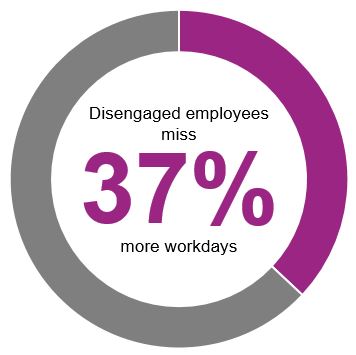We’ve written quite a bit about buyer personification, the buyer’s journey, and how to drive demand and leads – all of which are useful, but there’s a subtle piece of the growth puzzle that can hinder results for some Xerox partners: company culture.
It’s the narrative created intentionally or unintentionally by company leaders and perpetuated by employees and contractors. It embodies the sum total of your organization’s vision, values, practices, people, stories and physical space. And so, when it’s working well it drives productivity, happiness, customer acquisition, and customer retention.

Costs Tied to Negative Company Culture
Negative company culture comes at a high cost. For example, when employees are constantly pushed to perform better and faster, their organizations rack up 50% more in healthcare costs. But performance stress isn’t the only growth killer associated with company culture.
Disengaged employees miss 37% more workdays and have 49% more workplace accidents and lack of loyalty drives voluntary turnover resulting in 20% of the vacating person’s salary being spent on hiring and onboarding their replacement. [1]
Culture is Not About the Perks
Flex time, work from home, gym memberships, stocked fridges, and gadgets are nice but they don’t drive long-term stress reduction or prevent disengagement and loyalty challenges. [2] Studies show, the biggest factor that tangibly improves company culture is workplace well being, which begins with increasing employee engagement, acknowledgement, and camaraderie. [3]
Key Drivers in Workplace Well Being
A Colorado-based study [4] revealed that the impact of employee well being at work extends beyond performing job duties. It affects families and entire communities and it’s not fostered through an occasional pat on the back or employee of the month parking space.
It’s much more holistic than that. It’s cultivated through dedication to infusing positivity into a work environments and consciously demonstrating understanding, compassion, and gratitude across all departments and levels. Good cultures also address the physical, emotional, and financial health of the entire team.
Creating a Framework for Great Company Culture
It’s easy to offer quick fixes such as adding a ping pong table or buying lunch for the team and call it company culture, but these temporary solutions won’t alter the overall culture or drive growth. In order to cultivate the permanent productivity and engagement you need from staff, changes come slowly, methodically, and from the top down, but with buy-in from the entire organization.
Company Culture can (and Should) be Measured
Sometimes leadership teams, especially in smaller organizations assume their culture is fine because nobody comes forward with complaints. Often when that’s the case, owners and managers are surprised to learn the truth. In order to change culture, it’s important to understand and benchmark the ROI on your current culture.
However, it can be tricky to elicit authentic responses from employees so, just as Net Promoter Score (NPS) indicates customer satisfaction, there’s an employee Net Promoter Score (eNPS) that measures culture.
Tips for transforming your company culture:
- Choose a character trait such as “happiness” or “caring” that embodies the culture you want to create and align all actions from hiring to break room signage to meeting agendas with that trait.
- Focus on the positive at all times. Show gratitude, call employees out for their great work, and start meetings with positive sentiments and actions.
- You can’t change the world in a day. Focus on short, small gains to produce large impacts. Think about well being programs you can institute; collect aluminum cans and give the money to charity, have employees spend time each day helping someone in need, or bring in a massage therapist or financial advisor once a month.
- Plan time for employees to think critically away from the office and encourage connectedness and group cohesion. Beyond team building, great cultures make employees feel like they contribute positively to the lives of their co-workers and the world.
Addressing lagging company culture and evolving positive culture is one of the most important factors in business growth. Think about your employees as megaphones for your organization. They leave work at the end of the day but rarely do they completely stop thinking about their jobs.
Great culture facilitates positive thoughts about work, which in turn drives productivity and growth while promoting happiness at home.
Have an inspiring company culture story? Please join our partner-only LinkedIn group; we’d love to hear about your team!
 Become a Xerox Channel Partner
Become a Xerox Channel Partner
Contact your Xerox account manager, or review the Xerox Global Partner Program and apply to become a Xerox channel partner today, to find out how we will help grow your business.
[1] Proof That Positive Work Cultures are More Productive, Harvard Business Review, https://hbr.org/2015/12/proof-that-positive-work-cultures-are-more-productive
[2] Britain’s workers value companionship and recognition over a big salary, AAT, https://www.aat.org.uk/about-aat/press-releases/britains-workers-value-companionship-recognition-over-big-salary
[3] Whitepaper – Well-being in the workplace, Gallup, http://media.gallup.com/documents/whitePaper–Well-BeingInTheWorkplace.pdf
[4] How do you Inspire Engagement Among Employees, Corporate Well Being Blog, http://employeetotalwellbeing.com/blog/inspire-engagement-among-employees/
Subscribe to the Channel Partner Connection and receive email updates when we publish a new article.[wysija_form id=”1″]



